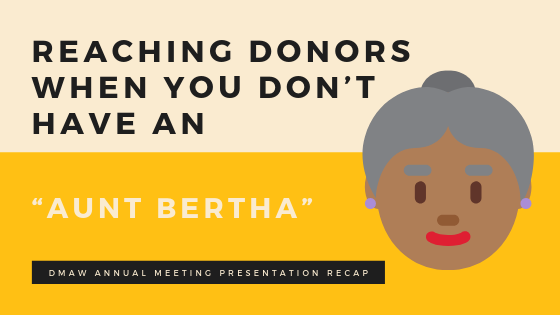Reaching donors when you don’t have an “Aunt Bertha”

I had the pleasure of attending the DMAW Annual Meeting and hearing from keynote speaker Nancy Harhut about how to hack the brains of donors, members, and other humans. It was fascinating!
Nancy shared a story about where her interest in fundraising began – at age eight when, incentivized by a banana-seat bike prize, she was tasked with selling Christmas cards to raise money for her school. Her loving Aunt Bertha helped her favorite niece out by pestering her factory co-workers to buy cards. Aunt Bertha was Nancy’s secret weapon – and you better believe she won that bike!
So, how do you reach your fundraising goals when you don’t have an “Aunt Bertha?” The answer: behavioral science. Yes, Bertha standing right in front of you ever so gently nudging you to buy Christmas cards from her niece is compelling. But nonprofits can be just as effective by leveraging some well-researched behavioral biases. And yes, there’s a science to it, but the root of its effectiveness is in its simplicity. Nancy shared three hacks to get into the brains of donors.
Hack #1: The brain prefers simple and easy
Simply put, our brains are lazy. They will look for shortcuts in decision making to conserve mental energy. Decisions are often not deliberate, but rather automatic and reflexive. Our brains need:
- Cognitive fluency: In direct response fundraising, this translates into using easy-to-read fonts, rhyming when possible, visual clues like handwritten arrows pointing to a package feature, and listing your calls to action in priority order.
- Choice architecture: Create the path of least resistance by providing “add to calendar” links and pre-selecting options like credit card processing fee add-ons. Just remember, there’s always a choice and we never want to force the behavior.
- Framing: Giving context to an offer has been shown to be more impactful. For example, lay out the consequence of saying no, relate a donor’s support to a benefit they care about (support our theater’s bathroom renovations!), give donors a new way to look at solutions, and anchor the offer in something familiar (for the price of a cup of coffee…).
Hack #2: People are most interested in themselves
Humans are hardwired for self-preservation and most people think they are better than average. So, reminding donors about what’s important to them is key. Try using:
- Personalization: Salutations, length of membership, location, specific local connection (We need 15 people from your state to donate!), and relatable tidbits resonate.
- Self-concept: Reinforce how people see themselves, label them, and help them be seen as they want to be (you are a loyal partner, carry our tote bag to show you are saving the planet!).
- Control and Choice: Leave the choice up to the donor – you choose the amount of your gift, you choose which premium you’d like, cancel any time. But limit the choices and make sure they are clear.
Hack #3: 80% of our decisions are driven by emotion.
People decide emotionally, and then justify rationally: I want that expensive thing. It’s okay that it’s over my budget because it’s on sale. Our emotions make us nearly incapable of choosing without fear, anger, pleasure, or guilt. Tap into the emotional centers of your donors via:
- Social norms: Everyone else is doing it, don’t you want to? Here’s what other people are doing and saying. C’mon!
- Loss aversion: Don’t miss out! This thing you love is going away soon. Matching gift deadline tonight!
- Storytelling: Specific and personal details evoke a mental visual that sticks with donors. And using actual visuals like photos and videos helps, too.
All nonprofit fundraising campaigns can benefit from these hacks – and many are already employing them. And now you know the reasons behind why they work and can use them more thoughtfully to motivate your donors even more. I think Aunt Bertha would be proud.

Barb Perell is Vice President of Marketing at Avalon Consulting and can be reached at barbp@avalonconsulting.net
